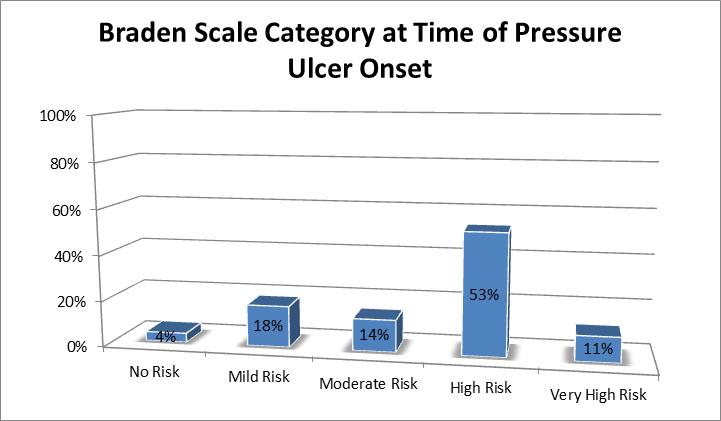Background:
The total cost for treatment of pressure ulcers in the United States is estimated at more than $11 billion annually. The Braden Scale is a risk stratification tool that assesses a patient’s risk of developing a pressure ulcer. It allows clinicians to develop risk-appropriate preventative interventions. Though used widely in the acute care setting, the scale does not include clinical factors that are unique to the acute care setting which may contribute to pressure ulcer development, such as a high catabolic state.
Methods:
A retrospective review of patient data at a major teaching hospital in New York City was performed. The most recent 100 hospital acquired pressure ulcers were analyzed with their corresponding Braden Scale Score at onset of the ulcer. The review assessed the accuracy and precision of the Braden Scale as a risk stratification tool in the acute care setting to predict the likelihood of developing a pressure ulcer. Each incidence of pressure ulcers and its documented Braden Scale was categorized by its corresponding risk level, and compared to a theoretical ascending incidence rate, from No Risk to Very High Risk.
Results: A total of 100 patients throughout the entire inpatient hospital service were analyzed. The results showed an inconsistency with the theorized ascending incidence rate, from None to Very High, as 18% of all pressure ulcers were documented in the Mild Risk category while only 14% were in the Moderate Risk category. Additionally, only 64% of all pressure ulcers were found in the High Risk/Very High Risk categories, indicating a 36% incidence of false negatives.
Conclusions:
This study highlights a 36% false negative rate of the Braden Scale within an acute care facility and questions the utility of the Braden Scale to stratify risk in an acute care setting, where factors such as a high catabolic state must also be taken into account. Improper use and over-reliance on the Braden Scale can lead to an under-assessed level of intervention with downstream clinical complications, increased healthcare expenditures and adverse events. Educating clinicians on the appropriate use of the Braden Scale is critical to improving long-term effectiveness of pressure ulcer prevention in the hospital and reducing the risks associated with misinterpretation of risk levels.
